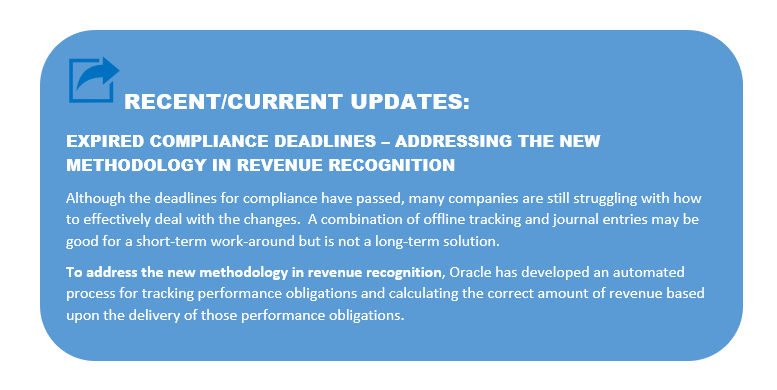MANAGING PERFORMANCE BASED REVENUE RECOGNITION
Accounting Standards Codification (ASC) 606
-CURRENT UPDATES-
This paper provides an update to one of our previous six-part blog series “Are you Ready for the New Revenue Recognition Standards?”
It outlined the May 28, 2014, announcement that the FASB and IASB jointly issued ASC 606, Revenue from Contracts with Customers. This change intended to standardize revenue recognition practices across industries as existing practices fall short when it comes down to how value is delivered to the client based on obligations explicitly or implicitly specified in contracts.
IN THIS LATEST SERIES, WE WILL RECAP AND HIGHLIGHT THE MOST CURRENT CHANGES SINCE THE DEADLINES FOR COMPLIANCE HAVE PASSED.
On May 28, 2014, FASB and IASB jointly issued ASC 606, Revenue from Contracts with Customers. Due to inconsistencies in revenue recognition among industries, and the disconnect between U. S. GAAP and IFRS reporting, the Boards collaborated to reduce or eliminate those inconsistencies and improve comparability between domestic and international best practices. The resulting standards will, therefore, significantly affect the revenue recognition practices of many companies.
Depending upon the business’ current model and revenue recognition practices, this standard could significantly impact the amount and timing of revenue recognition, which in turn will impact key performance measures and debt covenant ratios and may even change how the company looks at capital investment and compensation. The new standards are poised to change budgets, contract negotiations, and current business practices.
Industry-Neutral Revenue Recognition
The core principle in the converged standard requires that an entity recognize revenue to depict the transfer of promised goods or services to a customer in an amount that reflects the consideration in exchange for those goods and services. To accomplish this goal, a five-step process has been outlined in the new standard. Every contract with a customer should be analyzed using these five steps to afford accurate reporting.
Step 1 – Identify the Contract with the Customer – A contract is an agreement between two or more parties that creates enforceable rights and obligations. The guidance applies to all contracts that meet specific criteria defined within the standard.
Step 2 – Identify the Performance Obligations in the Contract – Performance obligations are promises to deliver certain goods and services to a customer.
Step 3 – Determine the Transaction Price – The transaction price is the amount an entity is expected to receive in exchange for transferring goods and services to a customer.
Step 4 – Allocate the Transaction Price – The relative standalone transaction price of each good or service being transferred to a customer, including discounts and other variable consideration amounts.
Step 5 – Recognize Revenue as Performance Obligations are Satisfied – This step happens when the goods or services are transferred to the customer. The customer will have taken control of the goods or services. The revenue recognized is the amount allocated to satisfy a performance obligation.
HOW CAN WE HELP YOU SUCCESSFULLY NAVIGATE THROUGH THESE CHANGES?
Project Partners will demonstrate how project-centric companies, using Oracle Projects and/or Oracle Project Contracts, can comply with the new standards with minimum disruption to existing business practices. View the 5-Step recap below.
ASC 606: REVENUE FROM CONTRACTS WITH CUSTOMERS
PART 1
The core principle in the converged standard requires that an entity recognize revenue to depict the transfer of promised goods or services to a customer in an amount that reflects the consideration in exchange for those goods and services. To accomplish this goal, a five-step process has been outlined in the new standard. Every contract with a customer should be analyzed using these five steps to afford accurate reporting.
STEP 1 IDENTIFY THE CONTRACT WITH A CUSTOMER
The new revenue guidance defines a contract as an agreement between two or more parties that creates enforceable rights and obligations. Essentially, all parties to the contract have to approve the agreement, are committed to fulfilling their obligations, and have Identifiable rights. The contract must have commercial substance, and collectability is probable.
STEP 2 IDENTIFY THE PERFORMANCE OBLIGATIONS IN THE CONTRACT
This step requires an entity to identify all the distinct performance obligations in a contract or arrangement. A performance obligation (commonly referred to as deliverables) is a promise to transfer goods or services to a customer. A good or service is distinct when the customer can benefit from said good or service on its own or with resources the customer already has. The good or service can be transferred to the customer independent of other performance obligations in the contract. Goods and services that are not distinct should be combined with other goods or services until the whole group is distinct.
To be distinct, a good or service must meet two criteria:
- It must be capable of being distinct, and
- It must be separately identifiable.
STEP 3 DETERMINE THE TRANSACTION PRICE
The Transaction Price is the amount of consideration an entity expects to receive for transferring goods or services to the customer. The amount can be fixed, variable, or a combination of both. Transaction Price is allocated to the identified performance obligations in the contract. These amounts are recognized as revenue when the performance obligation is fulfilled.
STEP 4 ALLOCATE THE TRANSACTION PRICE
Allocation of the Transaction Price comes into play when a contract contains more than one performance obligation. The seller should allocate the selling price to each performance obligation based on its relative Standalone Selling Price (“SSP”). The Standard permits any method of allocation of the SSP, just as long as that estimation accurately represents what price would be charged in separate transactions.
STEP 5 DELIVER SERVICES AND RECORD THE OUTCOME
The last step in the new revenue recognition standard is to recognize revenue when or as the performance obligations in the contract are completed. A performance obligation is completed when or as control of the good or service is transferred to a customer. The Standard defines control as “the ability to direct the use of and obtain all of the remaining benefits from the asset substantially.” (ASC 606-10-20).
The Standard allows revenue recognition based on two methods for measuring progress, Output, and Input.
Outputs are the result of inputs and processes of a business and are goods or services finished and transferred to the customer. The output method measures the results achieved. Surveys, appraisals, milestones reached, and units produced or delivered are all examples of output methods. Value to the customer is the objective measure of an entity’s performance.
Examples of an output method would include the number of feet of pipe used for a specific distribution project or the number of electrical poles used from a transmission plant to a final destination.
The input method is a more indirect measure of satisfying a performance obligation. Inputs are measured by determining the effort put into completing the contract. The input method is implemented by estimating the inputs required to satisfy a performance obligation and then comparing the effort expended to date against that estimate.
Examples of input methods would be cost-to-cost, labor hours, or material quantities.
The Board decided that, at least conceptually, an output measure is the best depiction of the entity’s performance because it directly measures the value transferred to the customer. Although the Boards did not state that the output method is the preferred method, they felt that, in most cases, it is the most appropriate method that is consistent with recognizing revenue as value is transferred to the customer. A drawback to this method is that there may not always be a directly observable output to measure progress reliably.
CLICK HERE for a more in-depth discussion of this topic and read full posts to the ASC 606 Series on our website.
CONTINUE TO NEXT POST 2 OF 2…
“Let’s take another in-depth look at how to use Oracle to comply with the newest revenue recognition rules”
www.projectp.com | Phone: +1.650.712.6200

